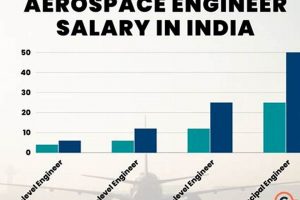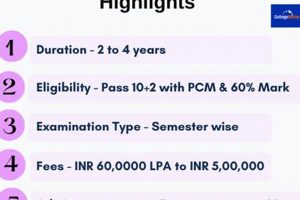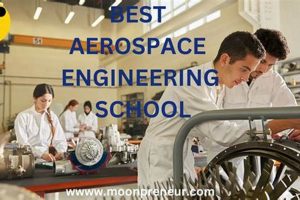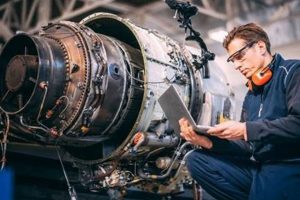Aerospace engineering encompasses a wide spectrum of responsibilities related to the design, development, testing, and production of aircraft and spacecraft. This field involves applying principles of engineering, science, and mathematics to create innovative solutions for air and space travel. Examples include designing more fuel-efficient airplane wings, developing propulsion systems for rockets, and creating life support systems for astronauts.
The significance of contributions from this engineering discipline is profound, affecting areas such as global transportation, national defense, and space exploration. Historically, advancements driven by these professionals have led to breakthroughs in materials science, aerodynamics, and communication technologies. The benefits extend beyond direct applications, stimulating economic growth and inspiring future generations of scientists and engineers.
The following sections will delve into specific aspects of the profession, detailing the diverse roles and responsibilities undertaken. This will include exploration of design processes, manufacturing techniques, research activities, and the application of advanced technologies utilized by those working in this specialized area of engineering.
Essential Considerations for Aspiring Aerospace Engineers
Succeeding in the field requires a combination of technical expertise, problem-solving skills, and a commitment to continuous learning. The following guidelines offer crucial advice for individuals pursuing a career in aerospace engineering.
Tip 1: Cultivate a Strong Foundation in STEM Disciplines: Rigorous coursework in mathematics, physics, and computer science is fundamental. A deep understanding of these subjects provides the necessary building blocks for advanced engineering concepts.
Tip 2: Gain Practical Experience Through Internships: Seek out internships at aerospace companies, research institutions, or government agencies. Hands-on experience supplements academic knowledge and provides valuable insights into real-world applications.
Tip 3: Develop Proficiency in Computer-Aided Design (CAD) Software: Familiarity with industry-standard CAD software is essential for design and analysis tasks. Practice using these tools to create models, simulations, and technical drawings.
Tip 4: Hone Analytical and Problem-Solving Abilities: Aerospace engineering involves complex challenges that require critical thinking and problem-solving skills. Practice analyzing data, identifying potential issues, and developing effective solutions.
Tip 5: Stay Current with Industry Trends and Technological Advancements: The aerospace industry is constantly evolving, with new technologies and innovations emerging regularly. Stay informed by reading industry publications, attending conferences, and participating in professional development activities.
Tip 6: Embrace Collaboration and Teamwork: Aerospace projects often involve multidisciplinary teams working together to achieve common goals. Develop strong communication and collaboration skills to effectively contribute to team efforts.
These recommendations highlight the importance of a strong academic foundation, practical experience, and continuous learning for individuals seeking a career. By focusing on these areas, aspiring aerospace engineers can enhance their prospects for success.
The subsequent sections will summarize key areas of expertise needed for a successful aerospace engineer.
1. Design Aircraft/Spacecraft
The activity of aircraft and spacecraft design constitutes a fundamental aspect of the work undertaken by aerospace engineers. This process involves the application of engineering principles to create detailed plans and specifications for aerial and space vehicles. Effective design directly influences the performance, safety, and efficiency of these vehicles. For example, the design of the Boeing 787 Dreamliner, emphasizing lightweight materials and aerodynamic efficiency, resulted in significant fuel savings and reduced emissions. This illustrates how design choices directly impact operational characteristics and environmental sustainability. Without capable design, the development of any successful aircraft or spacecraft is impossible.
Aerospace design is not a singular activity but rather a series of interconnected steps that often require collaboration with specialists in areas such as aerodynamics, structures, propulsion, and avionics. The design process usually begins with defining the mission requirements of the aircraft or spacecraft, followed by conceptual design, preliminary design, and detailed design. The practical application extends into the realm of unmanned aerial vehicles (UAVs), where design considerations must account for autonomous operation and payload capabilities. Each stage involves analysis, simulation, and testing to ensure the final product meets performance criteria and safety standards.
The crucial point is that success is dependent on a mastery of several skillsets. The design element serves as a cornerstone of aerospace engineering activity, significantly impacting advancement in transportation, exploration, and technology development. Thus, mastery in design is a must for every aerospace engineer. Challenges in optimizing the designs, however, requires continuous innovation and improvements in design processes and technologies.
2. Develop Propulsion Systems
Propulsion system development is a critical facet of the work performed by aerospace engineers. It encompasses the design, testing, and implementation of systems that generate thrust to propel aircraft and spacecraft. The efficiency and reliability of these systems directly influence vehicle performance, range, and payload capacity. For example, the development of high-efficiency turbofan engines has been instrumental in enabling long-distance air travel and reducing fuel consumption in commercial aviation. This engineering work is the fundamental driving force behind controlled movement within earth’s atmosphere and beyond. Without it, the aerospace industry would not exist.
The process involves a deep understanding of thermodynamics, fluid mechanics, and combustion. Engineers analyze various propulsion methods, including jet engines, rocket engines, and electric propulsion, to determine the optimal solution for a given mission. For instance, designing rocket engines for space launch requires careful consideration of propellant selection, nozzle design, and combustion chamber efficiency to maximize thrust and minimize weight. Further, electric propulsion systems, used in spacecraft for in-space maneuvers, offer high efficiency but produce low thrust, thus requiring long operational times.
In summary, developing propulsion systems is an integral component of aerospace engineering, driving advancements in air and space travel. Challenges in achieving higher efficiency, reduced emissions, and increased reliability demand ongoing research and innovation in this field. Its successful execution is fundamentally linked to advancements in aerospace technology.
3. Analyze Aerodynamic Performance
Analyzing aerodynamic performance constitutes an essential element within aerospace engineering. It involves evaluating how air flows around aircraft and spacecraft, influencing lift, drag, and stability. This analysis directly affects design decisions and operational parameters. For example, computational fluid dynamics (CFD) simulations are employed to assess the aerodynamic characteristics of a new wing design before physical prototypes are even constructed. Thus, aerodynamic analysis fundamentally impacts aircraft performance and safety profiles.
The practice extends beyond design, encompassing in-flight testing and data analysis to refine aerodynamic models. Engineers interpret data obtained from wind tunnels and flight tests, comparing it against theoretical predictions to identify areas for improvement. A real-world application is the development of winglets on commercial aircraft, designed through aerodynamic analysis to reduce wingtip vortices and induced drag, thereby improving fuel efficiency. A reduction in drag translates to lower fuel consumption, making commercial flights more economical and decreasing the impact of such flights on the environment.
In summary, aerodynamic performance analysis is inextricably linked to the core function of aerospace engineering. Its application spans from initial design to continuous improvement, directly impacting the efficiency, stability, and overall performance of aerospace vehicles. Continuous progress in this field requires continuous refinement of analytical tools and a comprehensive understanding of fluid dynamics principles.
4. Test Prototypes Rigorously
Rigorous testing of prototypes is an indispensable element of aerospace engineering activity. This process validates designs, identifies potential flaws, and ensures the safe and reliable operation of aircraft and spacecraft. The integrity of testing directly impacts the success of any aerospace project, influencing safety standards, performance metrics, and regulatory compliance.
- Wind Tunnel Testing
Wind tunnel testing involves subjecting scale models or full-size prototypes to controlled airflow to simulate flight conditions. This allows engineers to measure aerodynamic forces, assess stability, and identify potential design flaws before flight. For example, wind tunnel tests are crucial in the development of new aircraft wing designs to optimize lift and minimize drag. This stage is key to the development of the prototype and overall engineering.
- Flight Testing
Flight testing involves operating prototype aircraft or spacecraft under real-world conditions to evaluate their performance and handling characteristics. This phase validates design assumptions and identifies any unexpected issues that may arise during flight. The testing of the Space Shuttle involved extensive flight tests to assess its stability, control, and reentry capabilities, ensuring the safety of the astronauts and the success of the missions.
- Materials Testing
Materials testing assesses the strength, durability, and fatigue resistance of materials used in aircraft and spacecraft construction. This ensures that the materials can withstand the extreme stresses and temperatures encountered during flight. For example, composite materials used in modern aircraft undergo rigorous testing to verify their structural integrity and resistance to environmental factors, such as moisture and temperature variations.
- Systems Integration Testing
Systems integration testing involves verifying that all components and systems within an aircraft or spacecraft function correctly together. This ensures that the various systems, such as avionics, propulsion, and control systems, operate seamlessly and without interference. The testing of the James Webb Space Telescope involved extensive systems integration testing to ensure that all its components would function correctly in the harsh environment of space.
The multifaceted nature of prototype testing highlights its significance. Every step of testing influences the design process, material selection, and the integration of complex systems. Such actions are quintessential to aerospace engineering endeavors and directly affect the reliability, safety, and overall success of aerospace missions. Thus, thorough testing, and an informed data analysis are of paramount importance.
5. Manage Project Lifecycles
Managing project lifecycles is an integral facet of the responsibilities undertaken within aerospace engineering. It encompasses the planning, execution, monitoring, and closure of projects related to the design, development, and production of aircraft and spacecraft. Effective project lifecycle management is crucial for ensuring that projects are completed on time, within budget, and to the required specifications.
- Defining Project Scope and Objectives
This involves clearly defining the project’s goals, deliverables, and constraints. For example, in designing a new commercial aircraft, the scope might include specific performance targets, regulatory requirements, and budget limitations. Accurately defining the scope at the outset is essential for avoiding scope creep and ensuring that the project remains focused. Scope directly influences resource allocation and schedule development.
- Developing Project Schedules and Budgets
Creating realistic schedules and budgets requires careful estimation of tasks, resources, and costs. This includes identifying critical paths, allocating resources effectively, and managing contingencies. Delays in one area can have cascading effects on the entire project, potentially leading to cost overruns and missed deadlines. For example, scheduling the integration of complex avionics systems into a new aircraft requires precise coordination and detailed knowledge of dependencies.
- Risk Management and Mitigation
Aerospace projects involve significant technical and financial risks. Effective risk management involves identifying potential threats, assessing their impact, and developing mitigation strategies. For instance, potential supply chain disruptions for critical components require contingency plans, such as identifying alternative suppliers or stockpiling essential materials. Risk mitigation reduces the likelihood of project delays and cost increases.
- Stakeholder Communication and Coordination
Aerospace projects often involve multiple stakeholders, including engineers, managers, customers, and regulatory agencies. Clear and effective communication is essential for ensuring that everyone is aligned and informed throughout the project lifecycle. Regular project status reports, meetings, and reviews facilitate coordination and help to identify and address any issues that may arise. Open communication promotes collaboration and reduces misunderstandings.
The ability to effectively manage project lifecycles is a critical skill for aerospace engineers. It integrates all technical aspects of engineering activities with essential project management skills. The discipline ensures that projects are delivered successfully, contributing to the overall advancement and innovation within the aerospace sector.
6. Research Emerging Technologies
The investigation of emerging technologies is fundamental to aerospace engineering. It drives innovation, improves performance, and addresses future challenges within the industry. Exploration of new materials, propulsion methods, and digital tools impacts design, manufacturing, and operational efficiency, shaping the trajectory of aerospace development.
- Advanced Materials Development
This area focuses on creating and characterizing novel materials with enhanced strength-to-weight ratios, temperature resistance, and durability. Examples include carbon fiber composites, aerogels, and shape-memory alloys. The development of lightweight, high-strength materials directly enables the design of more fuel-efficient aircraft and spacecraft, thereby expanding operational capabilities while reducing environmental impact.
- Novel Propulsion Systems
Research in this domain explores alternative propulsion methods beyond conventional jet and rocket engines. Examples include electric propulsion, hypersonic propulsion, and fusion propulsion. Electric propulsion offers high efficiency for in-space maneuvers, while hypersonic propulsion aims to enable faster-than-sound air travel. Investigating fusion propulsion is critical for interstellar missions. These technologies directly affect the feasibility of future exploration and transportation initiatives.
- Artificial Intelligence and Machine Learning Applications
This field involves the application of AI and ML algorithms to optimize aircraft design, automate manufacturing processes, and enhance flight control systems. AI-powered systems can analyze vast amounts of data to identify patterns and make predictions, leading to improved performance and safety. Examples include autonomous flight control, predictive maintenance, and AI-assisted design optimization. AI enhances the capacity to manage complex systems and reduce operational costs.
- Quantum Computing and Sensing
This area explores the potential of quantum technologies to revolutionize aerospace engineering. Quantum computing can solve complex optimization problems that are intractable for classical computers, while quantum sensors offer enhanced precision and sensitivity. Applications include optimizing flight paths, simulating complex fluid dynamics, and developing ultra-precise navigation systems. These technologies have the potential to transform data processing and sensing capabilities, leading to breakthroughs in various aerospace applications.
These efforts in emerging technologies underpin progress in aerospace engineering, addressing current limitations and paving the way for future advances. Such investigation is fundamental to improving performance, enhancing safety, and expanding the scope of aerospace activities. Continuous research facilitates adaptation to new challenges and opportunities, ensuring the industry’s ongoing success.
Frequently Asked Questions Regarding Aerospace Engineering Roles
The following questions address common inquiries and clarify misconceptions concerning responsibilities in aerospace engineering.
Question 1: What is the primary focus of the profession?
The core emphasis is the design, development, testing, and production of aircraft and spacecraft, integrating engineering principles with scientific and mathematical knowledge.
Question 2: Are there distinct specializations within the area?
Yes, specializations encompass areas such as aerodynamics, propulsion, materials science, structural engineering, and avionics, allowing for focused expertise within specific domains.
Question 3: Does computer software play a role in their daily activities?
Certainly, proficiency in computer-aided design (CAD), computational fluid dynamics (CFD), and other simulation software is essential for design, analysis, and modeling tasks.
Question 4: What are the typical industries or sectors that employ professionals?
Employment opportunities exist within aerospace manufacturers, government agencies like NASA and the Department of Defense, research institutions, and consulting firms.
Question 5: Does this professional role involve outdoor testing or research?
Outdoor activities like wind tunnel testing, flight testing, and rocket launch monitoring are frequently part of the practical application of designs, though they are often balanced by more desk-based planning and analysis.
Question 6: What level of education is expected to enter into the field?
At a minimum, a Bachelor of Science degree in aerospace engineering or a related field is typically required, with advanced degrees often preferred for research and leadership positions.
In summary, a career demands continuous learning, interdisciplinary collaboration, and adaptation to technological advancements.
The next section offers advice on breaking into and excelling in aerospace roles.
Conclusion
This article has explored the multifaceted nature of the profession by illustrating “what type of work do aerospace engineers do”. Core responsibilities encompass the design and development of aircraft and spacecraft, management of complex project lifecycles, analysis of aerodynamic performance, rigorous testing of prototypes, development of innovative propulsion systems, and active engagement in researching emerging technologies. These activities require a combination of theoretical knowledge, practical skills, and adaptability to evolving industry standards.
The continued advancement of aerospace technology relies heavily on the expertise and dedication of these professionals. Their work has a profound impact on global transportation, space exploration, and national defense. Aspiring aerospace engineers should focus on acquiring a strong foundation in STEM disciplines, gaining practical experience through internships, and remaining current with industry trends. The challenges within this field demand innovation and commitment to the ongoing pursuit of knowledge, ensuring a future driven by progress in air and space travel.







